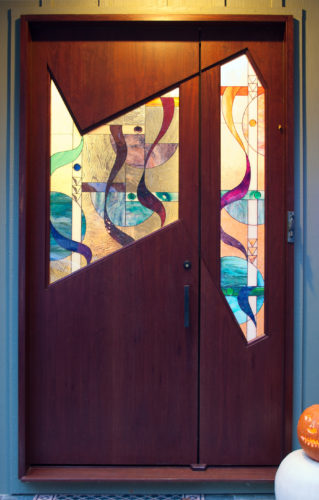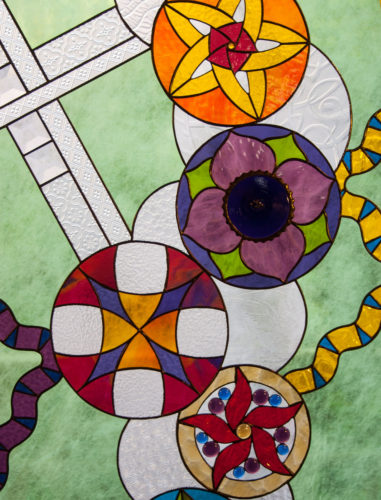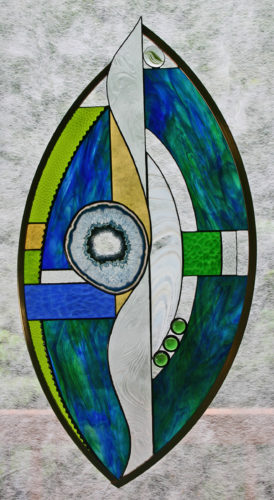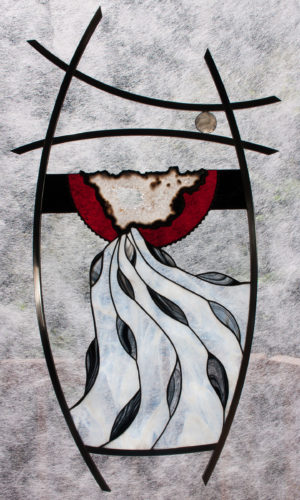 My original designs are mainly constructed in the copper foil method of stained glass, also known as Tiffany style. Each piece of glass is cut, ground, then wrapped with a copper foil tape. The solder adheres to the copper foil and that’s how the piece is held together.
My original designs are mainly constructed in the copper foil method of stained glass, also known as Tiffany style. Each piece of glass is cut, ground, then wrapped with a copper foil tape. The solder adheres to the copper foil and that’s how the piece is held together.
My styles range from geometric to abstract incorporating materials not usually found in stained glass art such as geode slices, mineral specimens, vintage glass jewels and thrift store finds. Select pieces are embellished with hand formed copper wire, etching, copper foil overlays and/or decorative soldering touches that adds texture. The panels are usually finished with either brass, copper or zinc metal came and in select pieces, I have a unique process of “sculpting” the came that encases the finished piece in a way that becomes part of the design, not just the supporting structure.
I moved to the mountains of Western North Carolina from Michigan in 1983. I grew up doing all kinds of arts & crafts and was drawn to a stained glass class offered through a local college in 1990 and immediately became addicted to its endless possibilities. In 1996 I was juried into the Southern Highland Craft Guild and in 2005 began offering stained glass classes in Hendersonville, NC, then in 2009 teaching at the John C. Campbell Folk Art School in Brasstown, NC.
I love working with the rich jewel tones as well as the heavily textured clear glasses. I’m like a kid in a candy shop when selecting glass! I especially enjoy working with clients to develop original, one-of-a-kind design possibilities for specific sites, sometimes starting with only a concept or idea. I still pinch myself because I can’t believe that this is what I get to do for a living… playing with sharp glass!
I consider my work as “Jewelry for your windows.”
Polymer Clay
While stained glass is my main artistic focus, I have become addicted to working with polymer clay. It’s a modeling clay that’s soft and malleable and is such a contrast to the hard, sharp glass I usually work with but both of them allow me to play with every color imaginable.
I love searching for unique, vintage and antique utensils at estate sales, thrift shops and garage sales then up-cycling them with polymer clay handles. They can be either brass, stainless steel, silver plate even gold plated stainless steel, and on very rare occasions, solid silver. I’m not sure which is more fun, finding them or identifying them because they come from all over the world. Many pieces are from here in the USA, but a lot of the vintage pieces were made in Japan. I’ve also found pieces from France, Germany, England, Thailand (some from Siam) Taiwan, Korea, China, Australia, Ireland, Denmark and Switzerland.
Depending on the type of handle the utensil has, I’ll either build a different shaped handle over the existing one with a base clay or, if it’s wood or plastic, I’ll remove the handle and fashion a new one with a wire armature for strength. Then they’re cured in a toaster oven at 275′ and sanded before covering them with a veneer from canes that I’ve created. A cane is a lot like a sushi roll. It’s a log made with polymer clay components to create a design that runs the entire length of the log. Once sliced, it will reveal the design and all slices from that cane will be identical. Canes are reduced by squeezing and compressing to make the log smaller hence, making the design smaller. The canes are thinly sliced and placed side by side to create a veneer and applied to the base handle. Once it’s cured again, it’s sanded with progressively finer grit sanding sponges and polished to a high sheen on a buffing wheel. Hand washing is recommended for theses utensils.
I just think it’s fun breathing new life into these old relics that will certainly dress up any buffet or dining table with a one of a kind piece of art!
Cheryl Stippich
Stained Glass
828-693-0781
theglassylady@bellsouth.net
cherylstippichstainedglassdesigns.com






